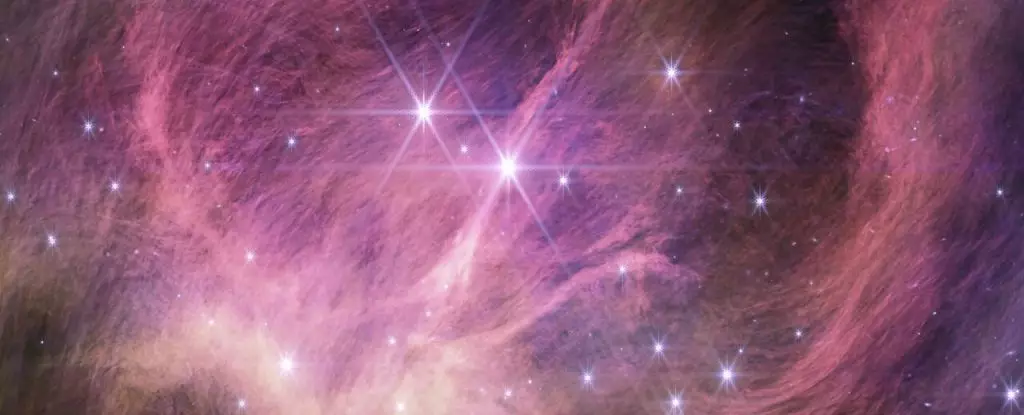The recent discovery of a record-breaking brown dwarf has left astronomers baffled and challenged in their understanding of the star formation process. This brown dwarf, with a mass of only 3 to 4 times that of Jupiter, appears to be the lowest-mass object of its kind found thus far. It is adrift in space, devoid of any companions, raising intriguing questions about its formation. While current models can easily explain the creation of giant planets in a stellar disc, the circumstances surrounding the birth of this brown dwarf in a star cluster make it highly unlikely that it formed in such a manner. The process by which a star forms at extremely small masses remains an enigma that astronomers strive to comprehend.
Brown dwarfs are often referred to as “failed stars,” although this designation may seem harsh; it is not entirely inaccurate. Stars come into being through the gravitational collapse of a dense clump within a cloud of gas and dust in space. As the mass accumulates, the pressure and heat in its core reach a critical point, initiating hydrogen fusion. The minimum mass required for this ignition is approximately 80 to 85 times greater than that of Jupiter. Although brown dwarfs go through a similar birthing process, they do not amass enough mass to satisfy the conditions necessary for hydrogen fusion. Nonetheless, brown dwarfs should not be considered planets either. They are smaller than white dwarf stars but larger than non-glowing “dark” planets. When a brown dwarf reaches a particular critical mass, around 13 times that of Jupiter, it can initiate fusion, albeit not of hydrogen but of its heavier isotope, deuterium. The fusion pressure and temperature for deuterium are lower than those for hydrogen. On the other hand, planets are formed through the gradual accumulation of material remaining after a star’s formation. Consequently, gravitational collapse leading to insufficient mass for fusion can still result in the formation of a brown dwarf. Astronomers may categorize such objects as sub-brown dwarfs, planetary-mass brown dwarfs, or rogue planets, depending on their formation route. Identifying the smallest of these astronomical entities is a subject of keen interest for a team of astronomers led by Kevin Luhman from Pennsylvania State University.
Luhman’s team employed the James Webb Space Telescope (JWST) to study the center of a young star cluster named IC 348, located approximately 1,000 light-years away in the Perseus star-forming region. Given that sub-brown dwarfs emit low levels of light and heat, an infrared instrument like the JWST, which possesses exceptional sensitivity, became an indispensable tool for their search. The near-infrared NIRCam was initially utilized to identify potential candidates, followed by the use of NIRSpec, the spectrograph, to analyze them. Three novel members of IC 348 were found that fulfilled the specified criteria, exhibiting masses between three and eight times that of Jupiter and temperatures ranging from 1100 to 1800 Kelvin (827 to 1527 degrees Celsius or 1520 to 2780 Fahrenheit). Of particular intrigue was the discovery of a record-breaking dwarf with a mass of around three to four Jupiters. This finding poses a genuine puzzle as, conventionally, star formation begins with a cloud containing considerable mass and gravity. Generating an entity the size of a planet necessitates starting with a smaller cloud, giving rise to less gravitational force. Consequently, the formation process becomes significantly more challenging, according to the researchers. While it remains plausible that these objects could be exoplanets expelled from their planetary systems, the likelihood is low. Additionally, most of the stars in IC 348 are relatively small, making it difficult to explain the formation of large planets around these stars. Moreover, the cluster’s youth means that there has not been sufficient time for planets to form and be ejected to such extreme distances from their systems. However, these mysteries are not the only ones unveiled by this research endeavor. Spectrographic analysis revealed the presence of an unidentified hydrocarbon in two of the brown dwarf candidates. Although this particular chemical species has been observed in the atmospheres of Saturn and Titan within our Solar System and within interstellar space, it had never been detected in an extrasolar atmosphere. The existence of this molecule challenges existing models of brown dwarf atmospheres.
The recent identification of a record-breaking brown dwarf has been pivotal in unmasking new complexities in our understanding of star formation. This intriguing astronomical object defies conventional explanations and has raised numerous perplexing questions for scientists to ponder. As they delve deeper into this new frontier at the intersection of stars and planets, researchers anticipate uncovering further secrets of the cosmos, bringing us closer to comprehending the intricate mechanisms by which celestial bodies are born.


Leave a Reply